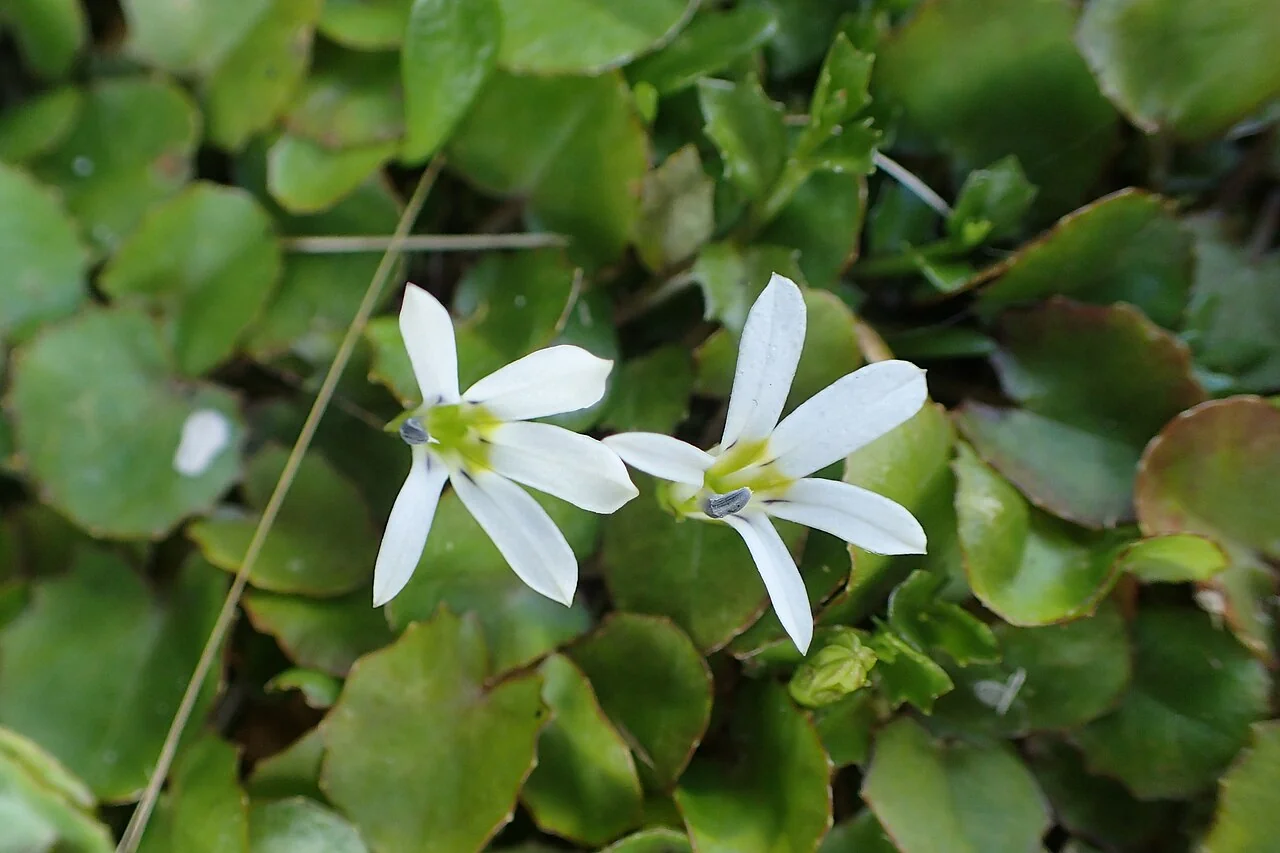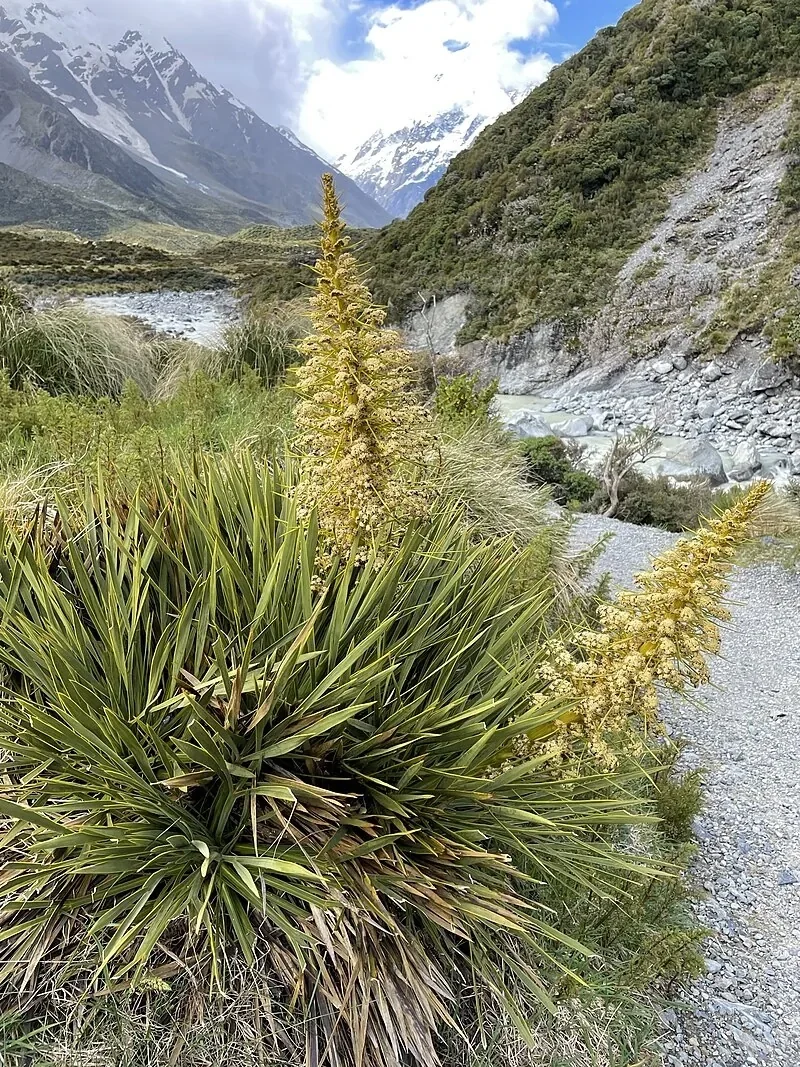
Pānakenake
Lobelia angulata
Pānakenake ( Lobelia angulata , formerly Lobelia angulata ) is a charming native New Zealand ground cover plant that forms dense, spreading mats perfect for challenging garden spaces. This low-growing perennial produces delightful white star-shaped flowers with yellowish interiors and striking purplish-red berries, making it both ornamental and ecologically valuable. Found naturally across New Zealand's North, South, and Stewart Islands from sea level to 1,300 metres, this hardy native thrives in moist, well-lit environments and can tolerate temperatures as low as -10°C. Its creeping stems root as they spread, creating attractive carpets up to one metre in diameter. Traditionally valued by Māori as an edible green , Pānakenake represents an excellent choice for sustainable native gardening in New Zealand.

Plant Description
Lobelia angulata (syn. Pratia angulata ) is a creeping, evergreen groundcover with small, glossy leaves, starry white flowers and translucent white to pale berries. Spreads readily by rooting stems.
Quick Facts
| Scientific Name | Lobelia Angulata |
|---|---|
| Common Name | Pānakenake, Blue Star Creeper, White Star Creeper |
| Water Needs | Regular watering - prefers consistently moist soil |
| Light | Full sun to partial shade - prefers well-lit areas |
| Frost Tolerance | Hardy - tolerates temperatures to -10°C |
| Salt Tolerance | Moderate - can handle some coastal exposure |
| Growth Rate | Fast - forms spreading mats within 1-2 seasons |
| Lifespan | Long-lived perennial ground cover (5+ years) |
| Plant Type | Low-growing, mat-forming perennial |
| Height | 5-10 cm |
| Spread | Up to 30 cm or more |
| Leaves | Small (1-2 cm), rounded or oval, glossy, dark green, often serrated |
| Flowers | Star-shaped, white with purple veins or blue, 1-1.5 cm diameter, yellow center (spring to late summer) |
| Fruit | Showy, spherical red to purple berries (up to 1/2 inch) |
| Growth Habit | Vigorous, evergreen creeper with angular stems that root as they spread |
| Growing Conditions | Moist, well-drained, humus-rich soil, full sun to partial shade, tolerates boggy conditions, hardy to some frost |
| Uses | Ground cover, lawn substitute, rock gardens, between stepping stones, edging, rain gardens, containers, hanging baskets |
Climate Best Suited to
Thrives in temperate, maritime climates with reliable moisture and cool to mild summers. It tolerates light frosts and sea breeze, performing best in partial shade or morning sun with afternoon shade in hot districts. In drier regions, plant where the root zone stays evenly moist without waterlogging.
Regional Suitability
| City | Climate Suitability |
|---|---|
| Whangārei | Ideal |
| Auckland | Ideal |
| Hamilton | Ideal |
| Tauranga | Ideal |
| Rotorua | Ideal |
| Gisborne | Ideal |
| New Plymouth | Ideal |
| Napier | Ideal |
| Whanganui | Ideal |
| Palmerston North | Ideal |
| Wellington | Ideal |
| Nelson | Ideal |
| Christchurch | Ideal |
| Dunedin | Ideal |
| Invercargill | Ideal |
Natural Habitat
Forest margins, damp lawns, stream banks and open scrub across much of New Zealand. It thrives where soils remain cool and evenly moist, often weaving between stones and roots to form a thin, resilient carpet. In coastal districts it settles in seepage zones and shaded banks, while inland it dots woodland edges and damp clearings after rain.
Conservation Status
Current Threats and Protection
Pānakenake ( Lobelia angulata , formerly Lobelia angulata ) maintains a conservation status of "Not Threatened" under New Zealand's threat classification system. This stable status reflects the species' widespread distribution and healthy population numbers across its natural range throughout New Zealand's three main islands and subantarctic territories.
The species demonstrates remarkable resilience and adaptability, naturally occurring from sea level coastal areas to alpine environments up to 1,300 metres elevation. This broad ecological tolerance contributes significantly to its secure conservation status, as the plant can thrive in diverse habitats from coastal margins to montane regions.
Pānakenake's conservation success is further supported by its vigorous growth habit and excellent reproductive capacity. The species spreads both vegetatively through creeping stems and sexually via seed production, ensuring robust population maintenance. Additionally, its value in sustainable horticulture and native plant gardens contributes to ex-situ conservation efforts while raising awareness of New Zealand's unique indigenous flora.
How to Grow
Planting Guide
Best Planting Practices
Prepare a fine, friable bed free of perennial weeds. Plant 0.3-0.5 m apart for rapid cover, water in well, and mulch lightly to conserve moisture while keeping crowns uncovered. Edge or install a shallow barrier where spread needs to be contained.
Ecology
Abundant white flowers provide nectar and pollen for small pollinators. After flowering, red berries attract birds, while the tight mat shelters ground invertebrates and suppresses erosion on gentle slopes.
Uses
Superb as a soft lawn alternative in low‑traffic areas, between stepping stones, and as a living mulch beneath shrubs. It also knits together edges of paths and retains soil on low banks in sheltered gardens.
Landscaping Ideas
Interplant with stepping stones and small hebes or native sedges for a layered groundcover. Combine with moisture‑loving ferns on the shadier side of paths to create contrast and seasonal texture.
Seasonal Care
Spring
Clip lightly to tidy winter growth and encourage fresh, flowering shoots; water if soils dry as buds form.
Summer
Maintain consistent moisture in heat; trim back runners that wander into beds and top up mulch, keeping it clear of crowns.
Autumn
Thin congested patches and replant divisions to extend coverage. Clear leaf litter that might smother stems in wet weather.
Winter
In colder areas provide protection from heavy foot traffic and saturated soils; check drainage so mats are not waterlogged.
Pruning
Pruning Techniques
Shear or mow on a high setting after flowering to refresh the mat. Hand‑pull stray runners and lift small patches to re‑lay where a tighter edge is desired.
How to Grow Pānakenake
Pānakenake is one of New Zealand's most rewarding native ground cover plants, offering year-round interest with minimal maintenance requirements. This hardy creeper adapts well to various garden conditions while providing spectacular seasonal displays of white flowers and colourful berries.
Seeds and Cuttings
Propagate pānakenake easily through stem cuttings taken in spring or autumn when growth is active. Cut 5-8cm sections of healthy stem with several leaf nodes and root in moist potting mix under humid conditions. Seeds can be collected from ripe berries and sown fresh in well-draining seed raising mix, though germination may be variable and slower than vegetative propagation methods.
Planting and Establishment
Plant pānakenake in spring after the last frost or in early autumn for best establishment. Choose locations with consistent moisture and good drainage, as waterlogged conditions can cause root rot. Space plants 30-40cm apart to allow for natural spreading, or plant closer for quicker coverage. Prepare soil by incorporating organic matter such as compost or well-rotted manure to improve moisture retention and fertility.
Growing Conditions and Care
Provide regular watering to maintain consistently moist soil, particularly during dry periods when the shallow root system may struggle. Apply a balanced, slow-release fertilizer in early spring to support vigorous growth and flowering. Mulch around plants with organic matter to conserve moisture, suppress weeds, and provide gradual nutrient release. Remove any dead or damaged foliage periodically to maintain plant health and appearance.
Seasonal Management
Spring brings renewed growth and the beginning of the flowering season - ensure adequate moisture as temperatures rise. Summer requires consistent watering and deadheading of spent flowers to encourage continued blooming. Autumn is ideal for division and transplanting as growth slows and weather conditions become more favorable. Winter care is minimal, though some protection may be beneficial in extremely exposed locations or during severe frost events.
Maintenance and Long-Term Care
Pānakenake requires minimal long-term maintenance once established, making it ideal for low-maintenance landscapes. Trim back overgrown areas in late winter to rejuvenate growth and maintain desired boundaries. The plant's natural spreading habit may require occasional management to prevent it from overwhelming nearby plantings, though its shallow root system makes removal relatively straightforward when necessary.
Pests and Diseases
Common Problems and Solutions
Generally healthy, especially in airy, moist but well‑drained sites. Slugs and snails may graze tender shoots in damp shade; hand pick, trap, or use barriers. Avoid chronic waterlogging to prevent rot, and minimise compaction from foot traffic in winter.
Cultural Significance
Traditional Uses and Values
Known to Māori as "pānakenake," this native plant holds important cultural significance as both a traditional food source and medicinal plant. Historically, Māori communities harvested the young leaves and shoots as kā kai (food), incorporating them into the traditional diet as nutritious edible greens. The plant's Polynesian name reflects its long-standing relationship with indigenous peoples of the Pacific region.
In traditional Māori understanding, pānakenake represented the concept of manaakitanga (hospitality) through its generous spreading nature and reliable food provision. The plant's ability to thrive in challenging environments while providing sustenance made it a valuable resource for communities, particularly in coastal and marginal growing areas where other food plants might struggle.
Today, pānakenake continues to hold cultural value as part of New Zealand's botanical heritage and native plant gardening movement. Its inclusion in contemporary landscapes connects modern New Zealanders with indigenous plant traditions while supporting biodiversity conservation. The species serves as an excellent example of how traditional ecological knowledge can inform sustainable horticultural practices and environmental stewardship.
Bonus Tip
Expert Growing Advice
For a resilient, even carpet, water deeply but infrequently to encourage roots to run, and avoid burying crowns with mulch. Where mats thin, patch with small plugs taken from vigorous edges in early autumn.







